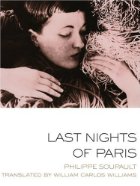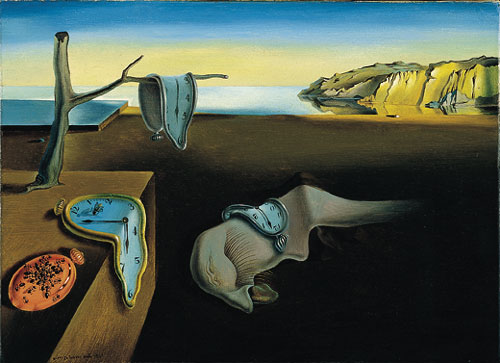
Hm, a ten-day blogging break: how did that happen? Actually I've been working on this post for about four days now, and I'm still not satisfied with it. (A sure sign I'm reading Virginia Woolf again is that I'm never satisfied with my own writing.) Still, it's time to cut the cord. Half-baked thoughts on Last Nights of Paris, for your amusement:
In the interests of ramping up the Parisian reading prior to the France trip, I picked up Philippe Soupault's 1928 Last Nights of Paris, as translated by American Modernist poet William Carlos Williams. I wanted to soak up a bit of surrealist love for the City of Light, and indeed, Soupault's work is a kind of proto-noir love letter to nocturnal Paris, in which various shady characters roam the banks of Seine between sundown and dawn, interacting in mysterious ways and becoming fascinated and disenchanted with one another. The city itself is the most vivid character here; the humans are merely atmospheric outgrowths of the Parisian streets, "types" of the romanticized thief or prostitute. One can trace the precise paths they take while roaming from the railings of the Louvre to the skeletal shadow of the Petit Palais, to to the unsavory ambiance of the Gare St. Lazare in the early hours, but beyond a stylish silhouette they hardly exist as people—or, if they have distinguishing characteristics, they come off more as accessories to the city itself, parts of a collective hive rather than individuals.
Soupault's atmospheric creation comes off well in its first half, which is intensely visual. One is constantly reminded that this work is part of the original Surrealist movement. Not only does the world of the novella qualify as "surreal" to modern sensibilities (featuring unexpected juxtapositions, jarring metaphors and non sequiturs), but even Soupault's specific images recall those of his influences and contemporaries. The opening chapter, for example, features a plethora of umbrellas, bringing to mind Lautréamont's "chance meeting on a dissecting table of a sewing-machine and an umbrella" line. (Unsurprising, since Soupault apparently idolized Lautréamont, holding him up as a role model for the Surrealist movement as a whole.) Some of the umbrella images are quite good, and good examples of the classic surrealist vibe of Last Nights of Paris:
It is said that along one side of it is the meeting place of monastic bachelors. A modest and silent club. Here umbrellas take on the appearance of a flock.
And again:
Dragging an umbrella as one drags along an unhappy cur, a couple passed on the quay and stopped an instant to cast a look around. The woman let out little shrieks that recalled those of a screech owl. They checked their umbrella on the steps of the Pont des Arts.
The metaphorical transformation of umbrellas into animate creatures—dogs, groups of birds—is very characteristic of Last Nights of Paris. The boundaries between animate and inanimate are unclear: Paris itself comes off as a living, breathing entity, and everything else, whether street or human, is something like an organ to its organic body. Likewise, the woman in the second quote reminds the narrator of a screech owl: human/animal boundaries are just as fuzzy as the borderline between animate and inanimate. Indeed, the narrator is more or less guided around the city during the first chapter by a stray dog, with mongrels appearing over and over throughout the novella. Soupault is not suggesting that these dogs have human-style intelligence, or some kind of mystic knowledge—only that conscious decisions are of less importance, in nocturnal Paris, than the vagaries of chance. The most fitting thing, given the spirit of the nocturnal city, is to abandon oneself to the random chance, investigating odd details that catch one's eye or simply drifting from encounter to encounter with no conscious goal. And even if one has a conscious goal, like the narrator's desire to know the explanation of the events he witnesses during the first chapter, one is most likely to find the answers through a kind of zen abandonment to accident, than through applied logic. As the narrator remarks in the latter half of the book (which is less visual, more conceptual, and I thought generally weaker):
The days when we follow the secret voice of diversion are those chosen by chance to show us its ways. [...] Boredom with the eternal pageant turned my thoughts to what you will. I fled voluptuously.
This preoccupation with chance and night time leads nicely into another of Soupault's trademark Surrealist touches. Scattered more widely throughout the novella as a whole are clocks: looming and ticking, often becoming loci of fascination for different characters, or malfunctioning in one way or another. The narrator notices, in one section, that his watch has developed an odd habit:
And meanwhile, as if in answer to the city's signal, the small clock I used to measure time and ennui stopped each evening at eleven thirty-five. There was no explanation for this disconcerting regularity.
I love the koan-style nonsensical-ness of this. For how long does the clock stop every evening; when does it start up again? Does the narrator reset it to make up for the time lost during the period when it was stopped, or does the ostensibly precise stopping time shift slightly every day as the clock's lost time interferes with its accuracy? Perhaps Soupault is suggesting that the measurement of time—and even more so, one might assume, the measurement of ennui—is a more subjective process than commonly believed, so that the lost time does not need to be taken into account, and whenever the watch displays 11:35pm, 11:35pm it will be as far as the narrator is concerned. This image of the elusive, adaptive clock anticipates Dalí's famous Persistence of Memory (1931), with its melting, traveling clock faces:
Elsewhere in Last Nights of Paris clocks are both reminders of the relativity of time (they are often unsynchronized, or malfunctioning), and simultaneously powerful creators of a moment in time. The character Octave is always staring at clocks, comparing them to his watch and to each other—presumably to check their agreement, reminding the reader of each timepiece's potential inaccuracy. In the opening chapter the "great clock of the Gare d'Orsay, the one on the left, pointed to three, strangest hour of all[, ...] three o'clock, the hour of indecision." Here the clock seems to embody and almost create the sense of this witching-hour in the narrator. The hands and face are less a neutral measurement device of an external quantity (time), but the co-creationist of a specific ambiance known as "three o clock." Could this 3am scene in the Gare d'Orsay achieve the same level of strangeness without the giant clock presiding over it? I think not. Elsewhere, the narrator himself becomes unreliable when he claims to know, without being told, that his friend Jacques "was obsessed with thoughts of a gigantic clock," and, finally, late in the book, chance itself is identified as "the hands of time."
I like Soupault's games here, but I'm not sure what to do with them. And in fact, after my delight at the visual oddity and atmospheric repetitions of the first half of this novella, I was taken aback to find myself slogging through the second half, which often reads like the journal of a stoned high school student or the more sophomoric passages of Julio Cortázar's Hopscotch. Still, at only 180 pages, 90 of which are delicious fun, and given the interesting geographical and historical context, Last Nights of Paris was definitely worth a read. And it will certainly flavor my impressions should I find myself in the neighborhood of the Louvre or Petit Palais after dark.
Thanks to blog buddy EL Fay for turning me on to Soupault! Even if I didn't love Last Nights of Paris quite as much as you did, that first 90 pages make it more than worthwhile.



